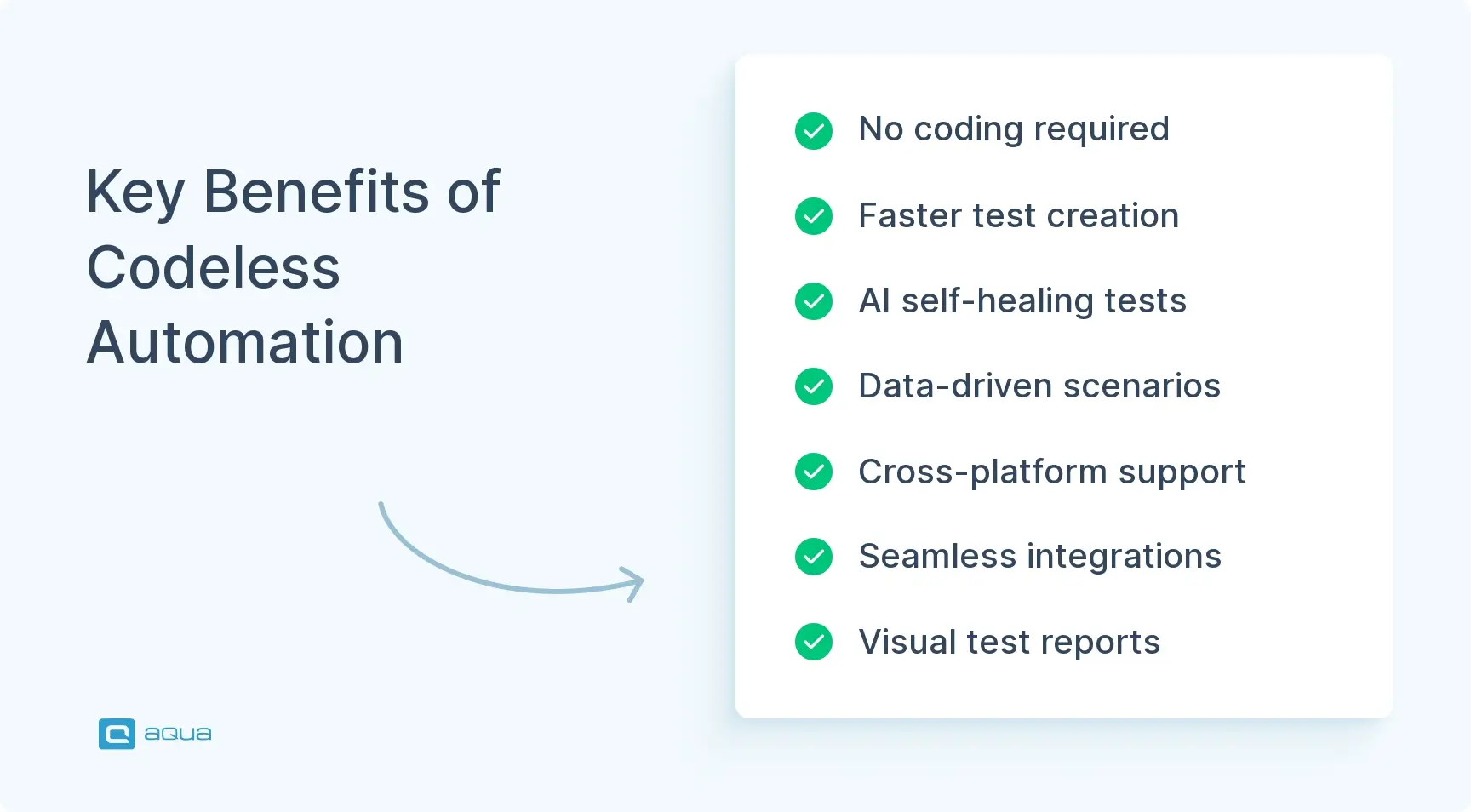Key Takeaways
- Codeless test automation tools enable non-programmers to create automated tests through visual interfaces like recording, drag-and-drop, or natural language instructions.
- Most codeless platforms feature AI-powered self-healing capabilities that adapt to UI changes, significantly reducing test maintenance compared to traditional frameworks.
- Codeless tools excel at functional UI testing but have limitations with complex scenarios involving intricate conditional logic, data manipulations, or custom calculations.
- The market offers various solutions ranging from simple browser extensions like Selenium IDE to comprehensive enterprise platforms like TestGrid and ACCELQ.
- Organizations typically achieve best results with a hybrid approach, using codeless tools for standard workflows while maintaining some coded tests for complex edge cases.
Codeless automation promises to democratize testing, but choosing the right tool requires evaluating your specific needs across technology compatibility, integration capabilities, and scalability requirements. Discover how to implement this approach successfully in your organization 👇
What Is Codeless Test Automation?
Codeless test automation lets you create automated tests without writing any code. Instead of learning programming languages like Java or Python, you use visual interfaces to build tests through recording actions, dragging and dropping elements, or describing what you want to test in plain English.
When you record a login sequence by clicking through the actual process, the codeless automation testing platform captures those actions and turns them into reusable test steps. The tool handles all the technical complexity behind the scenes, generating the code needed to interact with your application. You focus on what needs testing instead of how to write the test.
This approach works completely differently from traditional frameworks like Selenium, which require substantial programming knowledge. With automation testing tools, the technical barriers disappear. Your QA analysts and domain experts can build automated tests directly, without waiting for developers to translate their testing ideas into scripts.
Most no code testing automation platforms work across web applications, mobile apps, and APIs. They include everything you need for a complete testing workflow: test organization, scheduling, reporting, and execution, all without requiring coding skills.
The advantage of codeless mode of test automation becomes clear when you consider resource constraints. You can expand your automation coverage without hiring more programmers or training existing staff in multiple programming languages. Testing teams can move from manual processes to comprehensive automation faster than ever before.
Key Features of Codeless Automation Testing
What makes codeless test automation tools actually work for real testing teams? The answer lies in features that solve the daily frustrations you face with traditional automation.
Visual Test Creation That Makes Sense
The best codeless testing tools give you multiple ways to create tests without touching code. You can:
- Record real user interactions while clicking through your application
- Drag and drop test steps to build workflows visually
- Write test descriptions in plain English and let the tool figure out the technical details
This flexibility matters because different testing scenarios need different approaches. Sometimes recording is faster, other times building step-by-step gives you more control.
Tests That Fix Themselves
Here’s where codeless automation testing tools really shine compared to traditional frameworks. When developers change your application by moving buttons, updating IDs, or redesigning pages, your tests don’t immediately break.
Best no-code test automation tools use smart element recognition that adapts to UI changes. Instead of failing when a button’s ID changes, the test identifies elements using multiple properties like text, position, and function. You spend less time fixing broken tests and more time actually testing.
Data-Driven Testing Without the Complexity
Want to test the same login flow with 50 different user accounts? Instead of creating 50 separate tests, you can link one test to a CSV file or database. The codeless test automation tool runs your test repeatedly with different data sets, checking that your application handles all variations correctly.
This approach transforms how you think about test coverage. One well-designed test can validate hundreds of scenarios automatically.
Cross-Platform Testing Made Simple
The same test that works on Chrome desktop should work on Safari mobile, right? With traditional automation, making this happen requires browser-specific code and device compatibility handling. Codeless platforms handle this complexity for you.
Your tests run across different browsers and devices without requiring separate implementations. You design once and execute everywhere.
Integration That Actually Works
What good is automation if it doesn’t fit into your existing workflow? The best codeless test automation tools integrate seamlessly with:
- CI/CD pipelines like Jenkins and Azure DevOps
- Test management systems you already use
- Bug tracking tools like Jira
- Version control so your tests stay synchronized with code changes
Reports That Tell You What Matters
Instead of digging through log files to understand test results, modern codeless testing tools provide visual dashboards that show what’s working and what isn’t. You can quickly spot patterns in failures and identify which tests need attention.
Some tools even highlight flaky tests that pass sometimes and fail other times, helping you focus on the reliability issues that actually matter for your releases.

As we explore the evolution of testing approaches, it’s clear that codeless automation is making testing more accessible and efficient. But what if you could take this accessibility even further with AI-powered assistance? This is where aqua cloud transforms your testing efforts, particularly well if you want to implement codeless automation strategies.
Unlike basic record-and-playback tools, aqua cloud offers a comprehensive solution that unifies both manual and automated testing in a single platform. Its AI Copilot can automatically generate high-quality test cases from requirements with just a click, reducing test design time by up to 98% while ensuring comprehensive coverage. For teams transitioning to codeless automation, aqua’s Step Designer lets you create test cases combining both manual and automated steps without complex coding, perfect for organizations with mixed technical skill levels. What truly sets aqua apart is how it democratizes AI test automation benefits through its visual interfaces and reusable components. Non-technical team members can create, maintain, and execute tests through intuitive workflows, while test automation experts can leverage integrations with tools like Selenium, Playwright, and Cypress, alongside popular integrations like Jira, Azure DevOps, and Confluence. This balance makes aqua ideal for implementing the hybrid approach mentioned in our guide, where the entire team can contribute to quality assurance regardless of coding expertise.
Accelerate your testing transformation with AI-powered test automation that requires zero coding skills
Getting Started with Codeless Test Automation
Implementing codeless test automation in your organization doesn’t have to be overwhelming. With a structured approach, you can gradually build a robust testing framework that enhances your quality assurance process without disrupting existing workflows.
The first step is selecting the right codeless test automation tool for your specific needs. Consider factors like the types of applications you need to test (web, mobile, desktop), your team’s technical background, integration requirements with your existing toolchain, and budget constraints. It’s often valuable to create a scorecard of must-have features and evaluate several tools against these criteria.
Once you’ve selected a tool, start with a small pilot project rather than attempting to automate everything at once. Choose a stable part of your application with predictable behavior, perhaps a login flow or a basic form submission. This allows your team to learn the tool’s capabilities without the complexity of automating highly dynamic features.
Setting up your testing environment properly is crucial for success. Most no code test automation tools require some initial configuration, such as installing browser extensions, connecting to cloud testing services, or setting up integrations with your CI/CD pipeline. Following the tool’s documentation closely during this phase will save headaches later.
Creating your first test cases should follow best practices even though you’re not writing code. Break down test scenarios into clear, manageable steps with specific expected outcomes. For example, instead of a vague test like “check that the shopping cart works,” create specific tests for “adding an item to the cart,” “updating quantities,” and “removing items.”
Examples of effective test design in codeless automation testing tools include:
- Recording a complete checkout process and adding verification points after each major step
- Creating reusable components for common actions like login or navigation
- Setting up data-driven tests that verify form validation with multiple input combinations
When executing tests, start with manual triggering to observe how the tests run and what the results look like. Once you’re confident in the test stability, you can schedule them to run automatically as part of your regular build process or on a timed basis.
After tests run, analyze the results carefully. Most codeless tools provide detailed reports with screenshots or even videos of failed steps. Use this information to refine your tests and address any flakiness or reliability issues early on.
Top Codeless Automation Testing Tools
Which codeless test automation tool should you actually choose? The market is crowded with options, each claiming to solve all your testing problems. Let’s look at what’s really available and what works for different team situations.
| Tool | Main Features | Best For | Limitations | Pricing Model |
|---|---|---|---|---|
| TestGrid | AI-powered self-healing, cloud device lab, visual testing | Enterprise teams with diverse testing needs | Steeper learning curve for complex scenarios | Subscription-based with device minutes |
| Selenium IDE | Open-source, browser extension, simple record/playback | Small teams, getting started with automation | Limited to browser testing, basic reporting | Free |
| Testim | Smart locators, AI stabilization, visual editing | Web apps with frequent UI changes | Less robust for API testing | Per user/month with execution limits |
| ACCELQ | Codeless API & UI testing, natural language interface | Enterprise teams integrating API & UI testing | Enterprise-focused, less suited for small teams | Enterprise licensing |
| testRigor | Plain English test creation, extreme abstraction | Non-technical teams, complex UI applications | Higher cost, less direct control | Per test case pricing |
| Perfecto Scriptless | Cloud testing, self-healing, visual analysis | Mobile and web testing at scale | Requires Perfecto subscription | Part of Perfecto platform |
| Leapwork | Visual flowchart interface, desktop app support | Business users, ERP/desktop application testing | Higher pricing tier | Enterprise licensing |
| Ranorex | Hybrid recording/coding, desktop application support | Teams that need desktop and web testing | More technical than some alternatives | Perpetual license or subscription |
| Mabl | AI-powered, cloud-native, auto-healing | DevOps-oriented teams with CI/CD focus | Limited desktop application support | Subscription with parallel runs |
Choosing the Right Codeless Automation Tool
The table shows features, but your success with any no-code automation testing platform depends on factors that don’t fit in neat columns. Community support matters when you’re stuck at 2 AM trying to figure out why your tests suddenly stopped working. Documentation quality determines whether you can actually use those fancy features or just get frustrated trying to understand them.
Many vendors offer free trials, which sounds helpful until you realize that evaluating a testing tool properly takes weeks, not the typical 14-day trial period. You need time to integrate with your applications, train your team, and discover the quirks that only show up after extended use.
Codeless/low code solutions are for very standardized products like CRM where business knowhow > development. It makes 0 sense for those type of companies to hire their own devs if extensions/customizations are handled by 3rd parties. You can teach those tools within a week and get quite good results. Of course, this comes with the downside of flexibility.
Industry-Specific Considerations
Some tools excel in particular environments that might match your situation perfectly. Healthcare applications often need specialized compliance features that general-purpose tools don’t provide. E-commerce sites have unique testing patterns around payment flows and inventory management that certain platforms handle better than others.
The right choice depends on your team’s technical background and the complexity of what you’re testing. A small team working on a straightforward web application might find Selenium IDE meets their needs perfectly, while an enterprise dealing with complex applications across multiple platforms might need the comprehensive capabilities of TestGrid or ACCELQ.
Making the Decision
Don’t get overwhelmed by feature lists. Start with your actual testing challenges. Do your tests break constantly when developers make UI changes? Look for tools with strong self-healing capabilities. Is your team completely non-technical? Focus on tools with natural language interfaces. Are you testing across multiple devices and browsers? Prioritize platforms with robust cross-platform support.
The real decision comes down to three critical factors that determine whether a codeless automation testing tool will actually work for your team. First, test it with your actual applications during the trial period: compatibility issues that seem minor in demos become major headaches in real use. Second, ensure your intended users can actually operate the tool effectively; if your business analysts or manual testers struggle with the interface during evaluation, they’ll struggle even more under deadline pressure. Finally, calculate the total cost including training, infrastructure, and scaling expenses, not just the license fee. Most teams underestimate these hidden costs and end up with budget surprises six months later when they need more test execution capacity or additional user seats.
The best codeless test automation tools are the ones that solve your specific problems without creating new ones. Sometimes, the simplest option that works is better than the most feature-rich platform that nobody on your team can figure out how to use effectively.
Codeless vs Low-Code vs No-Code Automation
The terms “codeless,” “no-code,” and “low-code” get thrown around interchangeably, but they represent different approaches that matter when choosing your testing strategy.
No code (or codeless) testing means zero programming required. You create tests through recording, drag-and-drop interfaces, or plain English descriptions. Anyone who understands your application can build automated tests without technical knowledge. The trade-off is flexibility: you’re limited to what the tool can handle through its visual interface.
Low-code test automation solutions give you visual test creation for most scenarios but let you add custom code when needed. You might build 90% of your test visually, then write a few lines of JavaScript for complex validation logic. This works well for teams with mixed technical skills.
Traditional coded automation requires programming everything from scratch. Maximum flexibility, maximum complexity, maximum time investment.
| Aspect | No-Code/Codeless | Low-Code | Traditional Coded |
|---|---|---|---|
| Technical Skills Needed | None | Basic coding helpful | Programming proficiency required |
| Test Creation Speed | Fastest | Fast with flexibility | Slowest |
| Flexibility | Limited to tool capabilities | Good with code extensions | Complete control |
| Best For | Non-technical testers | Mixed-skill teams | Complex custom scenarios |
Most successful teams use a hybrid approach. Your business analysts create standard workflow tests with codeless test automation tools, while developers handle complex edge cases with traditional coding. You get broad test coverage without requiring everyone to become programmers.
The right choice depends on who’s doing your testing and what you’re testing. Start with the simplest approach that covers your needs, then add complexity only when necessary.
Future Trends in Codeless Test Automation
What’s coming next for codeless test automation? The changes happening now will determine whether your testing approach stays relevant or gets left behind.
AI Gets Smarter About Test Creation
Codeless test automation with AI is moving beyond simple self-healing. New tools can analyze your application and suggest which tests you actually need, instead of leaving you staring at a blank screen, wondering where to start. Some platforms already examine user behavior patterns and recommend test scenarios based on how people really use your software.
This shift means you might soon start with AI-generated test suggestions rather than building everything from scratch. The time savings could be significant, especially for teams testing complex applications with hundreds of possible user paths.
Talk to Your Tests
Natural language processing is making it possible to create tests by simply describing what you want to check. Instead of clicking through interfaces, you can say “make sure users can’t place orders with expired credit cards” and the system builds the test for you.
This conversational approach to testing is already working in tools like testRigor, and it’s likely to become standard as the technology improves. The barrier between thinking about a test and creating it continues to shrink.
Key Changes Worth Watching
Several other developments are changing how no code automation testing actually works:
- Cloud-first everything – Testing platforms run entirely in the cloud, spinning up test environments on demand and running hundreds of tests in parallel. You don’t need to maintain local infrastructure or worry about scaling capacity.
- Visual regression detection – Tools now catch visual bugs automatically, spotting when buttons move, colors change, or layouts break. This goes beyond functional testing to ensure your application looks right, not just works right.
- Cross-platform simplification – The same test runs on web, mobile, and desktop without platform-specific modifications. You design once and execute everywhere, reducing the maintenance burden significantly.
- Earlier testing integration – Codeless test automation connects directly with development environments, letting you test requirements before code is even written. Testing shifts from an end-of-cycle activity to an ongoing validation process.
What This Means for Your Team
The democratization of testing continues expanding. Business users, product managers, and domain experts can contribute to test creation without learning programming languages. This trend aligns with the broader movement toward citizen development, where non-technical people build and maintain business applications.
The best codeless test automation platforms will eventually handle emerging technologies like augmented and virtual reality applications, addressing the unique challenges of testing 3D environments and spatial interactions.
For teams planning their testing strategy, these trends suggest that codeless automation will become more capable and accessible over time. Starting with current tools and evolving with new capabilities makes more sense than waiting for the “perfect” solution that may never arrive.
As we’ve seen throughout this guide, codeless test automation represents a significant evolution in software quality assurance by breaking down technical barriers and enabling broader team participation. But implementing a successful codeless strategy requires the right platform that can truly deliver on these promises.
aqua cloud stands out as a complete test management solution that excels at making automation accessible without sacrificing power or flexibility. Its unified platform brings together manual and automated testing, allowing you to manage everything in one place while integrating seamlessly with your CI/CD pipelines and existing tools like Jira and Azure DevOps. What makes aqua particularly valuable for codeless automation is its AI Copilot, which can automatically generate comprehensive test cases from requirements, reducing test design time by up to 98%. This AI-driven approach, combined with visual test development interfaces and reusable components, empowers everyone on your team to contribute to testing, regardless of technical background. Whether you’re just starting your automation journey or looking to scale existing efforts, aqua provides the perfect balance of accessibility and sophistication. Say goodbye to the limitations of traditional testing approaches and embrace a solution that grows with your testing maturity, all without requiring extensive coding knowledge.
Reduce test creation time by 98% with AI-powered test automation that everyone on your team can use
Limitations of Codeless Test Automation
Codeless automation isn’t magic, and pretending it solves every testing problem sets your team up for disappointment. Understanding where these tools struggle helps you build a realistic testing strategy that actually works.
Complex Logic Hits a Wall
When your test needs to verify intricate financial calculations, handle complex conditional logic, or perform custom data transformations, visual interfaces start breaking down. You can’t easily express “if the user’s account balance is negative and they’re in a specific geographic region, apply this particular fee structure” through drag-and-drop components.
These scenarios often require the flexibility of actual code, which brings you back to traditional automation approaches for your most complex test cases.
Limited Testing Types
Most codeless tools focus on functional UI testing and don’t handle other crucial testing types well. Performance testing, security validation, and low-level component testing usually still require specialized tools or custom coding. This means codeless automation covers part of your testing pyramid, not the whole thing.
The Vendor Lock-In Reality
Tests created in one codeless platform typically can’t move to another. If you need to switch tools later, you might rebuild your entire test suite from scratch. This dependency can become expensive and limiting as your testing needs evolve.
When Things Go Wrong
Debugging failed tests becomes more challenging when you can’t see the underlying code. Traditional frameworks let you examine exactly what happened at each step, while codeless tools often provide less detailed failure information. You might know a test failed, but understanding why takes longer to figure out.
Making It Work Despite the Limits
These limitations don’t make codeless automation worthless—they just mean it works best as part of a balanced testing approach. Use codeless tools for standard user workflows and functional validation, then complement them with traditional automation or specialized tools for complex scenarios.
The key is matching the right tool to the right testing challenge instead of forcing everything through a single approach that wasn’t designed for every situation.
Incorporating Codeless Testing into Your Team
Rolling out codeless test automation successfully requires more than buying a tool and hoping people figure it out. Your implementation approach determines whether the tool becomes a valuable asset or expensive shelfware.
Start Small and Build Momentum
Pick enthusiastic early adopters for your pilot project, not skeptics who’ll find reasons why the tool won’t work. Choose a bounded project scope that delivers quick wins, maybe automating login flows or basic user registration. These early successes create internal advocates who can coach others and demonstrate real value.
Don’t assume visual interfaces mean zero learning curve. Even codeless automation requires training on test design principles, assertion strategies, and maintenance practices. People need to understand how to create effective tests, not just how to click through the tool’s interface.
Build Supporting Structure
Establish standards from the beginning. Create templates, naming conventions, and reusable components that prevent your test suite from becoming an unmaintainable mess. Someone needs to own test quality, even when the tests don’t involve traditional coding.
Integrate codeless tests into your CI/CD pipeline immediately. Tests that run separately from your regular development workflow become forgotten tests. Make them part of your quality gates so they actually influence release decisions.
Handle the Cultural Shift
Your team dynamics will change when non-developers start creating automation. Developers might resist the idea that “anyone can automate,” while manual testers might feel overwhelmed by suddenly owning test maintenance responsibilities. Address this friction directly by showing how codeless automation complements existing skills rather than replacing them.
Create feedback loops to improve your approach over time. Review which tests provide value, which ones require constant maintenance, and where the tool reaches its limits. Adjust your strategy based on what you learn, not what the vendor promised during the sales demo.
The goal is expanding your team’s automation capabilities without creating chaos. Done right, codeless automation empowers more people to contribute to quality assurance while maintaining the standards that make automation valuable in the first place.
Conclusion
Codeless test automation breaks down the technical barriers that kept your domain experts and business analysts on the sidelines of quality assurance. When implemented thoughtfully, these tools expand who can contribute to testing without sacrificing the rigor that makes automation valuable. The key is starting with realistic expectations, choosing the right test management tool for your specific needs, and building good practices from day one. Codeless automation won’t solve every testing challenge, but it can significantly expand your team’s ability to catch bugs early and deliver better software faster when used alongside traditional testing approaches.

















